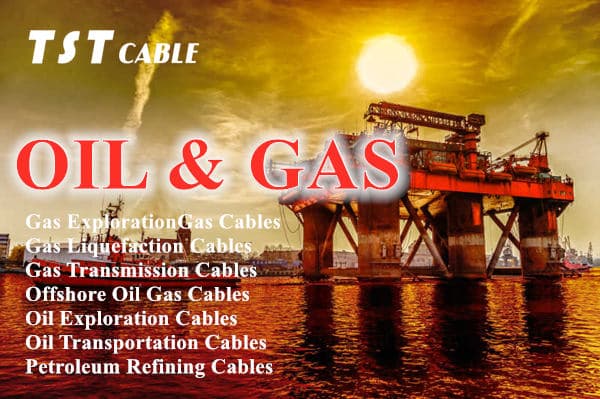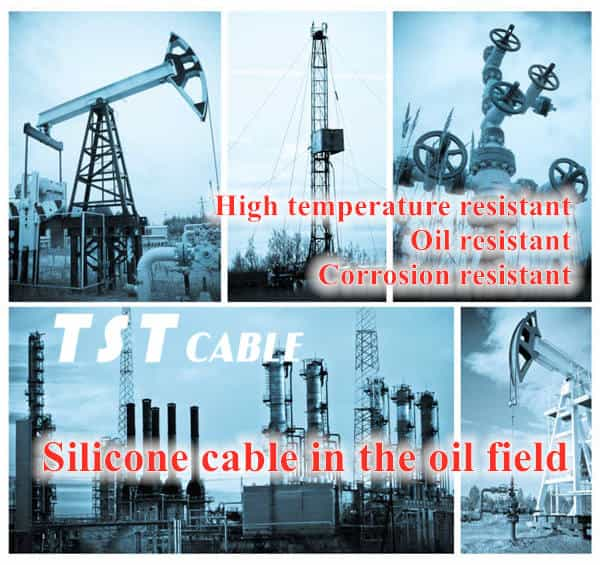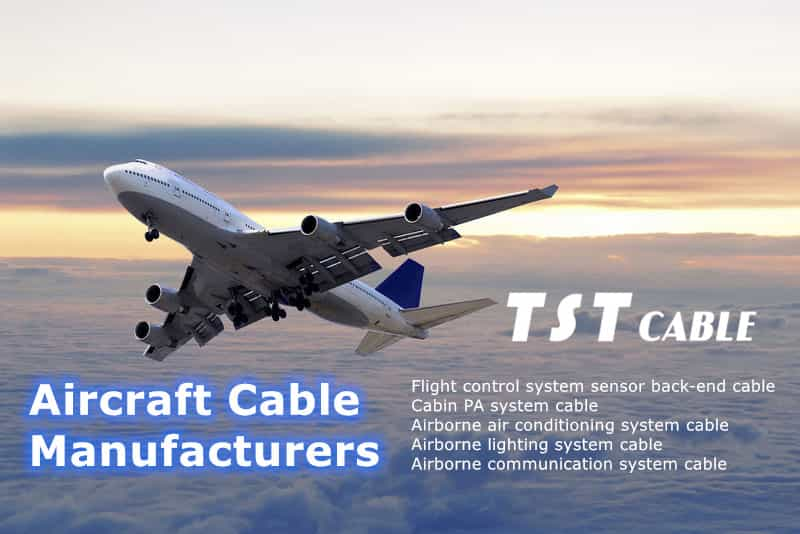
At present, there are not many domestic manufacturers of oil and gas industrial cables, TST CABLES mass production of products such as medium and deep well logging cables, submersible oil pump cables, high temperature oil pump cables, submersible halogen pump cables, small diameter logging cables, integrated logging cables, injection cables, heating cables, electrode system (also known as bridle) cables and ultrasonic oil recovery cables, etc., and it is likely to be able to obtain large-scale production of the following Ultrasonic oil recovery cable, shot hole cable and heating cable.
The use of special cables for the oil industry
Specialty cables are basically used under the same conditions as logging cables, most of which are short-term use of the product, but according to the different regions of the oilfield, the use of different requirements, the main factors are also: ground temperature gradient, bottom pressure and well medium. The common characteristics of these cables are:
1. harsh conditions of use, large amount of damage, short replacement cycle;.
2. Use of the environment is high temperature, high pressure and even the presence of H2S.
3. In the oilfield exploration, mining, transportation of all periods of time are used.
I. Exploration cable:
Mainly used for geological exploration and logging operations, these cables require a high degree of abrasion resistance, corrosion resistance and tensile resistance to cope with drilling activities in complex formations.
The structure usually contains multiple strands of finely stranded oxygen-free ultra-fine copper wires as conductors, as well as high mechanical properties of the insulating material to ensure the accuracy of signal transmission and the durability of the cable.
Special such as seawater-proof cables are able to resist salt water corrosion and are suitable for offshore exploration.
Second, shot hole cable
As the name suggests is through the oil pipe with a shotgun, in a certain part of the shot hole. The original shot hole is to use the old logging cable pressure well to shoot holes, with the new cable can be installed in the wellhead equipment, without pressure well can be shot holes in the required parts, is a safe, high-speed shooting method, especially for the old oil wells to check the layer to fill the holes is an effective method.
Three,Heating cable
Heating cable is used in oil wells with high wax content. At the beginning, the wells in some areas of Daqing Oilfield were blocked due to high wax content, and heating was used. Later, heating cables were also used in high viscosity wells in order to improve the fluidity of oil.

Fourth, the sonic oil recovery cable
The use of sound waves in thousands of years ago has been discovered, from musical instruments to instrument research has been a lot. As an industrial application is a matter of recent decades. In the petroleum scientific research in the use of sound waves began in the United States and the Soviet Union and other countries. 7 has been using heating and chemical methods for processing, large investment, complex processes, the effect is not ideal. Sonic waves have stronger penetrability than electromagnetic waves, and sound waves can easily enter the oil, water and strata and other substances that electromagnetic waves cannot penetrate. Sonic waves will obviously affect the physical properties and flow pattern of the liquid, improve the circulation conditions and permeability of the bottom of the well, and thus increase the production of the well, which has been proved in foreign countries. Therefore, sonic oil wells to increase production, water wells to increase injection, sonic decongestion to induce spraying, ultrasonic anti-wax, anti-scaling and so on have been in a large number of applications.
V. Transportation cables:
Involves the extraction of oil or natural gas through the pipeline to the treatment or storage facilities of the power supply and control signal cables.
These cables often need to be weatherproof and able to work stably in extreme temperatures, humidity or corrosive environments.
Six, the main materials used in cables
The common characteristics of these three types of cables are: copper conductive core, polypropylene insulation, plus padding after the double steel wire armor, the process and logging cables are the same, they are basically the same materials.
With the development of China’s central and western, the development of the petroleum industry has become more prominent. In addition to the “West-East Gas Pipeline” has begun, large oil fields “Sea of Hope” has also been developed. In addition to capital construction requires a large number of general-purpose cables, cables for the oil industry will also develop. This gives us an opportunity to develop new varieties of cable industry.
Seven, TST CABLES oil and gas cable advantages:
- Oil resistance: Due to direct contact with crude oil and natural gas, cables must have excellent oil resistance to ensure that the insulation is not rapidly aged or damaged by oil erosion.
- Corrosion resistance: in environments containing salt water, acidic gases and other corrosive media, the cable sheath and insulation need to have good chemical resistance to maintain long-term stable operation.
- Flame retardant and fire protection: cables need to meet high standards of flame retardant requirements, can be in the event of a fire to slow down the spread of fire, reduce the risk of secondary disasters, such as the use of ZR (flame retardant) and IA (fire-resistant) grade cables.
- Cold and high temperature resistance: from the extreme cold of the Arctic to the heat of the desert, oil and gas cables need to be able to perform consistently over a wide range of temperatures and are typically designed to operate in temperatures ranging from -40°C to +90°C (and beyond).
- Mechanical strength and tensile strength: When drilling in deep wells, on offshore platforms or laid on the ground, cables are often subjected to pulling, crushing and abrasion, and therefore require strong armor layers and reinforced mechanical structures to withstand high mechanical stresses.
- Explosion protection: In areas where explosive gases or dusts may be present, cables must comply with explosion-proof safety standards, such as explosion-proof construction or intrinsically safe design, to prevent explosions caused by electrical sparks.
- Signal integrity: for the transmission of control signals cable, need to have excellent shielding performance, reduce electromagnetic interference (EMI), to ensure that the signal is clear and error-free.
- Adaptation to complex installations: cable design needs to be easy to install in narrow, winding space, while having the flexibility to bend and fast connection characteristics, in order to adapt to offshore platforms, drilling platforms and underground pipelines and other complex environments.
- Long Life Cycles: Given the high cost of replacement, oil and gas cables are often designed for long life and low maintenance requirements to accommodate long periods of uninterrupted operation.
TST CABLES Oil & Gas cables are high-performance products customized to meet the industry’s extreme working conditions and stringent safety standards, ensuring the stable and safe transmission of power and signals in a variety of complex environments.
TST CABLES, the world’s leading supplier of specialized oil and gas cables
In the vast journey of energy exploration, every challenge to penetrate deep into the earth’s core is inseparable from a strong and reliable partner – TST CABLES special cables for oil and gas. We know that in the harsh environment of the oilfield, every inch of cable carries the weight of safety and efficiency. Therefore, TST CABLES oil cables use the most advanced manufacturing process, combining high-strength conductors and special insulation materials that are resistant to extreme environments, to ensure the stable transmission of power and data in high-temperature, high-pressure, corrosive oil and gas fields, and to protect your exploration, extraction and transportation tasks. If you are in need of oil and gas cables, please feel free to contact us by email to receive free samples.


